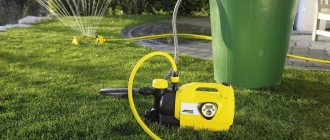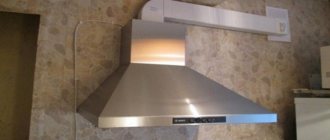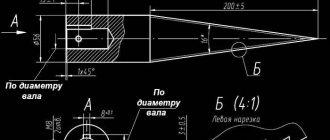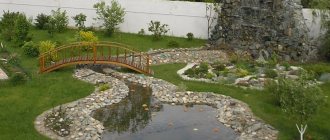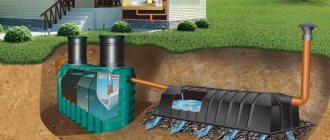Sewerage is one of the most important engineering systems of a country house. The level of comfort of those living in the cottage largely depends on its correct and uninterrupted operation. Often, novice developers, trying to save money, rush to make a septic tank without proper knowledge about the absorption capacity of the soil on the site, the groundwater level and sanitary standards applicable to this type of structure. As a result, the septic tank turns into an ordinary cesspool filled with water.
The matter is aggravated by the fact that no one has the desire to dig up pipes or climb into already commissioned wells filled with “black and gray waters” in order to eliminate a breakdown or carry out modernization. There is only one way out - to do everything right the first time, and the experience of a portal user with the nickname PavelTLT will help you with this.
Types and features of septic tanks
The simplest and most primitive septic tank is a two-chamber cesspool, the primary chamber of which must be periodically cleaned. Its disadvantages are well known - not the most pleasant smell and the release of practically untreated wastewater into the soil. Plus – relative complexity in technical implementation.
Cesspools
It is with a cesspool that great difficulties arise when choosing its location - after all, from the point of view of financial costs and effort, it is most convenient to place the pit as close to the building as possible. But the presence in such a septic tank (which is practically not a sealed container) of a considerable amount of contaminants, with a high degree of probability falling directly into the ground, dictates the need to move the septic tank as far as possible.
Cesspools will have to be cleaned quite often Source dom-expert.by
Factory-made septic tanks
The most acceptable option for incorporating wastewater into the local ecosystem is to install an industrial-made septic tank. Such equipment, due to the peculiarities of its design, is distinguished by almost ideal performance characteristics :
- light weight;
- ease of installation;
- strength of the body made of polymer materials;
- high degree of purification of contaminated water;
- complete processing of mud masses;
- complete autonomy;
- minimum maintenance.
If it is not possible to use special equipment, then, if necessary, modern septic tanks can be installed manually, but knowledge of the technology is still indispensable
The hardest part of the work is digging a hole for the septic tank and a trench for sewer pipes Source m.2gis.ru
See also: Catalog of companies that specialize in water supply and sewerage.
Exploitation
It's one thing to build a sewer system. The other is to operate correctly so that the system functions at a sufficient level.
So, let's look at how to maintain and operate a septic tank:
- Waste must be drained regularly to ensure bacterial life.
- It is prohibited to drain caustic chemicals (acids, alkalis, petroleum fluids, surfactants, etc.)
- It is necessary to periodically clean out bacterial waste products (silt deposits)
- Do not dump household waste.
If all requirements are met, such a sewer system will serve you for decades.
Criteria for choosing a location for installing a septic tank
The choice of installation location for a septic tank, even if it is completely sealed, is determined not only and not so much by the convenience of construction work and maintenance. The determining factors here are sanitary and epidemiological standards and rules - for example, those reflected in SNiP 2.04.03-85. According to these rules, the location of the septic tank must satisfy the following conditions:
- the distance to the nearest source of drinking water (well, well) should not be less than 30 m;
- there must be more than 10 m to a stream, river or other natural body of water;
- the distance to the external walls of a residential building should not be less than 4 m;
- the boundary of the site should not be closer than 3 m;
- the nearest public road should not be less than 5 m.
In addition, a septic tank in a private house should not be located close to trees - a minimum distance of 2 m.
General rules for choosing a location for a septic tank Source agrognom.ru
Additional terms
It is necessary to take into account not only these mandatory standards (if violated, significant sanctions from supervisory authorities are possible!), but also take into account local conditions. These include both soil characteristics (depth of groundwater and soil freezing, site topography) and the presence or possibility of connecting associated utilities - some types of factory-made septic tanks are volatile and require a three-phase power supply.
The design and dimensions of treatment plants are not standardized, however, when choosing the location of treatment stations, it should be taken into account that the main drain pipe must approach the septic tank with a slope of at least 2 degrees. In other words, take into account the required pit depth and the technical feasibility of meeting it.
How to choose the right model?
When choosing elements of a wastewater treatment system, the determining factor is the number of people permanently residing in the house. According to the standards, each resident needs 200 liters per day. Therefore, the minimum productivity of a septic tank for a small family of three people is 600 liters per day.
In combination with Tank septic tanks, Triton-400 infiltrators are used. Their quantity is also selected taking into account daily water consumption. The absorbency of soils is also taken into account - for clay representatives, the number of buildings is doubled.
The number of infiltrators depends not only on the performance of the septic tank to which they are connected, but also on the filtration properties of the soil
Tank septic tanks are available in different modifications, each of which is equipped with manufacturer’s recommendations:
- Tank 1 – suitable for serving three permanent residents and a daily wastewater volume of up to 600 liters. It has overall dimensions of 1.2 m x 1 m x 1.7 m, weight – 75 kg. One infiltrator is mounted in a chain with it when installed on peat and sand deposits, and two on clay soils.
- Tank 2 – processes up to 800 liters of wastewater per day, capable of serving up to four people. Dimensions – 1.8 m × 1.2 m × 1.7 m, installation weight – 130 kg. Two infiltrators go to it, and four are installed on clayey rocks.
- Tank 2.5 – daily capacity is one thousand liters, dimensions – 2 m × 1.2 m × 1.85 m. Suitable for four to five people. Weight – 140 kg. The number of infiltrators is similar to the Tank 2 installation.
- Tank 3 – the septic tank provides water disposal in the amount of 1200 liters, serving five to six family members. The weight of the installation is 150 kg, dimensions are 2.2 m × 1.2 m × 2 m. In areas with peat and sandy soils, three infiltrators are connected to it, in sandy loams and loams - six.
- Tank 4 - installed to drain wastewater from one or more buildings and serve up to nine permanent residents. Productivity – up to 1800 liters per day. The weight of the septic tank is 230 kg, overall dimensions are 3.6 m × 1 m × 1.7 m. Together with it, four infiltrators are installed on sand and peat, eight – on clay and loam.
If the amount of wastewater constantly exceeds the recommended amount, then insufficiently purified water will be discharged into the ground and the ecosystem of the site may suffer.
Too large a septic tank volume will not be economical and will require more space. It is worth choosing a tank with greater productivity if the house often receives guests or if the number of residents is planned to be replenished.
The septic tank model is chosen taking into account the volume of water consumption, which depends on the number of residents of the house
Selection of septic tank performance
The main technical characteristic of any septic tank is its productivity, which characterizes the volume of wastewater received and processed over a certain period of time; usually within a day. It depends, first of all, on the volume of the settling chamber, and secondly, on the technology used in the treatment unit for purifying contaminated water.
Inside, the septic tank consists of several divisions, so its real performance cannot be determined based on an external examination. Source kzs-septik.ru
If you liked the article, please share it
Previously on the topic:
Share
Scheme of the treatment system
Having decided on the volume of the settling tank, you should think over and draw up a diagram of the treatment plant, which should take into account all local features. Since installing a septic tank correctly means ensuring its long-term operation without unnecessary headaches, it is necessary to calculate all possible options.
The simplest version of the treatment system includes the following main elements:
- a pipeline connecting the outlet of the home sewer system to the receiving chamber of the septic tank;
- receiving (septic) chamber;
- pipeline from the chamber to the soil treatment plant (if its installation is planned);
- aeration fields for the final treatment of wastewater and its transfer into the ground.
Scheme for removing treated wastewater from a septic tank through a filtration field - if the level of wastewater treatment is low, then approximately once every 10 years you will have to dig up the filtration field and wash or change the crushed stone Source rinnipool.ru
The first stage is digging a pit
The dimensions of the pit must exceed the width and length by 40 cm. The depth depends on many factors: on the depth at which the clay and limestone begin;
from the groundwater level. The landscape greatly influences it. Call us for a consultation so that we can correctly indicate to you which depth to choose. Ideally, there should be 50-60 cm above the container. Dimensions of the pit in millimeters for different models:
- ST-1 1400x1600;
- ST-1.5 1500x2300;
- ST-2 1500x3000;
- ST-3 1600x3000;
- ST-4 1600x4000;
- ST-5 1600x4800.
Selection of materials
The main part of the septic tank is the waste chambers, which can be made of a variety of materials:
Septic tanks made of plastic
The most common material for pipelines is a polypropylene pipe of suitable diameter. It is inexpensive, light in weight, has very high strength and is easy to process. If desired, you can also use asbestos-cement, cast iron or other metal pipes - but their service life is significantly shorter than that of polypropylene, and the cost is much higher.
The septic chamber is usually made of plastic or reinforced concrete; in simple cases, brick can be used. Using iron barrels of a suitable size as containers is a bad idea: they not only rot quickly, but also pollute the soil as they rust. The ideal option is industrially manufactured septic tanks, easy to install and reliable in operation.
Construction of a septic tank for a private home - a plastic version of a septic tank Source plastlist.ru
Laying a sewer line from the building
It is important to maintain a slope of 1-2%; too large an angle will inevitably lead to clogging and growth of fat on the walls. Of course we avoid sharp corners. It is advisable to install tees for future cleaning every 10 meters. Make the inlet pipe locally (or in advance at our factory) coaxially with the flow. Don't be lazy to use the level. With it, it’s not difficult to arrange everything correctly.
Installation of septic tanks
Installing a septic tank always begins with digging a pit of the required size. When installing ready-made, factory-made “tanks,” it is imperative to provide a concrete pad to which the septic tank will need to be secured so that it is not pushed out by heaving forces.
Septic tank on a concrete pad Source proseptik54.ru
In addition to the hole for the septic tank itself, it is necessary to dig trenches for the supply of sewer pipes and the removal of treated wastewater. If the septic tank will be used all year round, then the pipes must be laid below the freezing level of the soil.
The septic tank is being connected to the sewer system.
Completion of excavation work: the gap between the walls of the pit and the outer side of the walls of the box is filled with any available material; usually - with soil removed when digging a pit.
Work methodology
Briefly, the procedure for installing a septic tank looks like this:
- they dig a pit of such depth that the inlet of the septic tank is located at a mark that provides the required slope to the pipe laid from the house, with a diameter of: 110 mm - 20 mm/m, 50 mm - 30 mm/m;
- In order to reduce the volume of excavation work, the pit for the septic tank is made of concrete rings in steps: each subsequent chamber is located lower than the previous one. The dimensions of the pit in plan exceed the dimensions of the septic tank: plastic - by 20-30 cm in each direction, made of concrete rings - by 50-80 cm around the perimeter (it will need to be covered with waterproofing from the outside);
- arrange a rammed sand cushion of 15-20 cm at the bottom. Having poured sand 5-7 cm thick, water it and compact it thoroughly, then lay the next layer in the same way;
- if a purchased plastic septic tank is installed, a reinforced concrete slab is laid on top of the sand: the treatment facility is attached to its eyes with cables. The fact is that such tanks, when empty, due to their low weight, are forced to the surface by ground moisture (“float”), which is why they require attachment to heavy ballast;
- install a ready-made plastic septic tank or build it from reinforced concrete rings. The first to be placed are special rings, capped on one side. If there are none, you will have to arrange the concrete bottom yourself;
- Before installing the next ring, a jute cord is placed in the groove at the end of the already installed one, then a waterproof mixture is applied to the end: “Aquacement” or cement mortar with the addition of liquid glass.
It is recommended to use rings with a lock that prevents lateral movement. The last chamber of a concrete septic tank is made without a sealed bottom - it is a drainage well for discharging clarified water into the ground.
Three-chamber septic tank
Crushed stone is poured into it in a layer of 1 m. The finished structure is covered with a reinforced concrete slab with holes for hatches (through which pumping is carried out) and ventilation. When backfilling a pit for a concrete septic tank, a mixture of soil and sand is used, for a plastic septic tank - sand and cement in a 5:1 ratio with layer-by-layer tamping and wetting.
As a result, a cement casing is formed around the tank, blocking the compressive effect of frost heaving forces. Before backfilling the pit, water is poured into the plastic septic tank, otherwise it will deform when the mixture is compacted.

